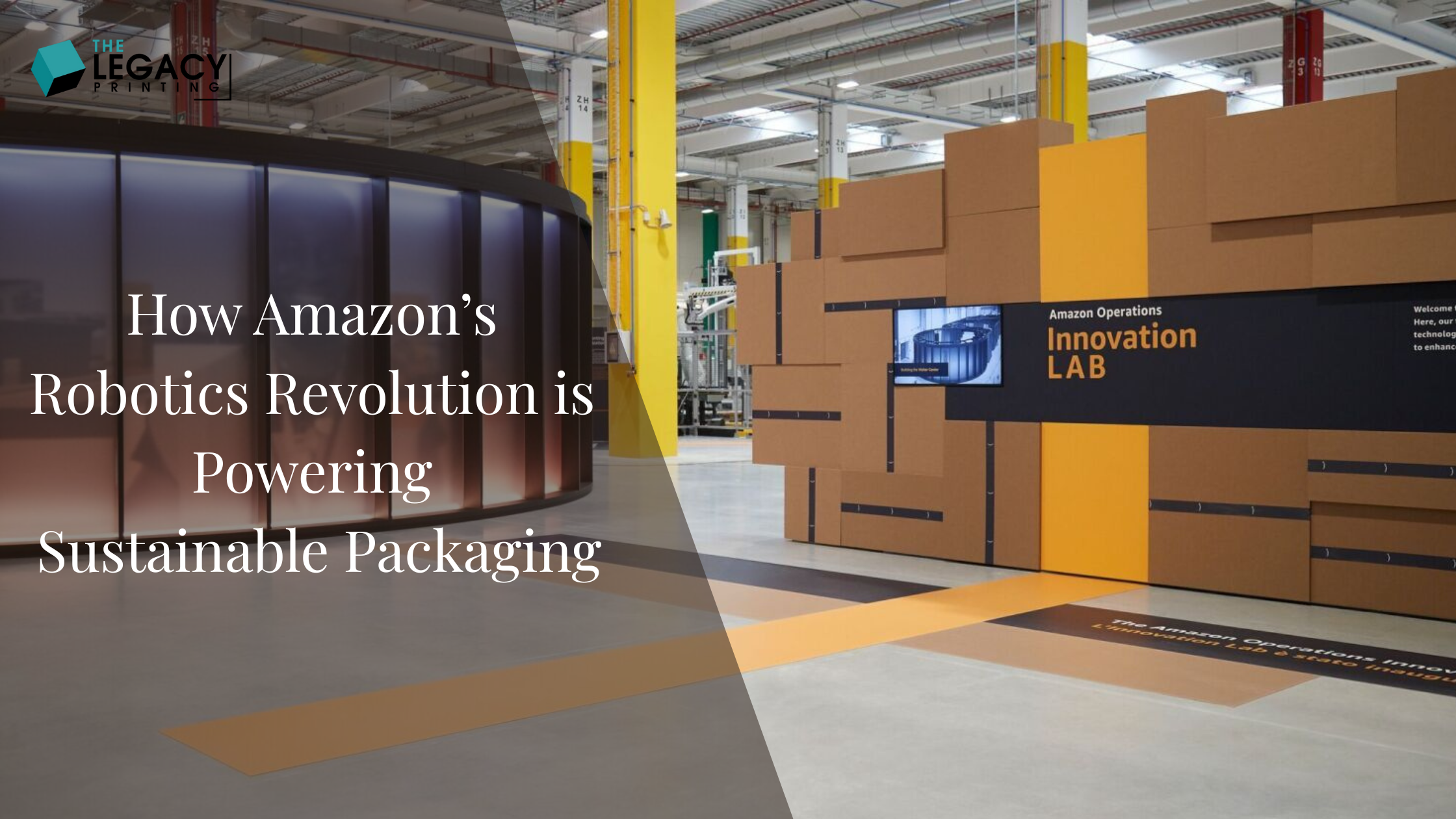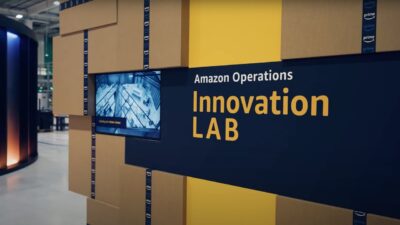How Amazon’s Robotics Revolution is Powering Sustainable Packaging

In an era where rapid commerce meets environmental responsibility, Amazon’s Operations Innovation Labs are leading the charge in transforming logistics through cutting-edge robotics, artificial intelligence (AI), and a steadfast commitment to sustainable packaging. These labs, located in Vercelli, Italy, Sumner, Washington, and Boston, Massachusetts, are not just research hubs but active testing grounds where sustainable packaging innovations are shaping the future of global commerce. By prioritising employee safety, customer satisfaction, and environmental stewardship, Amazon is redefining how logistics can balance efficiency with eco-conscious practices. This article explores the groundbreaking advancements in sustainable packaging, robotics, and workplace safety at Amazon’s labs, highlighting their role in delivering exceptional customer experiences while advancing towards a net-zero carbon future by 2040.
The Heart of Innovation: Amazon’s Operations Innovation Labs

Nestled in Italy’s picturesque Piedmont region, an hour from the Italian Alps, Amazon’s Vercelli Operations Innovation Lab, established in 2019, is a cornerstone of the company’s European efforts in sustainable packaging and logistics. This facility, integrated within an existing fulfilment centre (FC), brings together engineers, scientists, and innovators to develop technologies that enhance worker conditions, streamline operations, and prioritise sustainable packaging to reduce environmental impact.
Unlike traditional research facilities, Vercelli is a dynamic test bed where sustainable packaging solutions, robotics, and AI-driven systems are trialled and refined before global deployment. The lab’s mission is guided by three core principles:
- Improving employee conditions through automation and safety-focused technologies.
- Elevating customer experiences with faster, more reliable deliveries.
- Reducing environmental impact through sustainable packaging and waste reduction.
In 2023, Amazon opened the Vercelli facility to the public with a dedicated visitor centre, offering free guided tours to showcase its advancements in sustainable packaging and robotics. Visitors enter the “experience centre,” scanning a QR code to access a digital map that illustrates Amazon’s click-to-delivery journey. Iconic items like the Kindle—used by FC employees to operate robotic systems—and the eco-friendly Amazon delivery box, a hallmark of sustainable packaging, are prominently displayed, symbolising the fusion of technology and environmental responsibility.
Robotics: Transforming Efficiency and Safety
Amazon’s Operations Innovation Labs are pioneering robotics that enhance efficiency while prioritising employee safety, with sustainable packaging playing a pivotal role in reducing waste. These technologies ensure faster deliveries and safer workplaces, aligning with Amazon’s customer-centric and eco-conscious ethos.
Flat Sorter Robotic Induct (FSRI)
The Flat Sorter Robotic Induct (FSRI) is a standout innovation, an AI-powered machine that uses vision sensors to sort items by size and destination with precision and speed. By automating sorting, the FSRI reduces manual handling, allowing employees to focus on higher-value tasks while supporting sustainable packaging by ensuring packages are grouped efficiently for delivery. Richard Zeger, Senior Robotics R&D Manager and Head of the Vercelli Innovation Lab, explains: “It makes sorting so much easier for FC workers and basically removes the step of needing to manually sort packages that head to the same direction.” This efficiency reduces the need for excess packaging materials, reinforcing Amazon’s commitment to sustainable packaging.
Bags Containerisation Matrix Sorter (BCMS)
The Bags Containerisation Matrix Sorter (BCMS) revolutionises package grouping by bundling items headed to the same postal code into a single bag, enhancing delivery capacity and reducing manual labour. This system supports sustainable packaging by minimising the number of individual packages, which lowers material use and carbon emissions—key steps towards Amazon’s net-zero carbon goal by 2040. By streamlining logistics, the BCMS ensures customers receive their orders faster while advancing sustainable packaging practices.
Enhancing Workplace Safety
Robotics at Amazon’s labs are designed to create safer workplaces by automating repetitive tasks and heavy lifting. The FSRI and BCMS reduce physical strain on employees, while patented safety vests signal robots to pause when workers are nearby, enhancing safety in busy fulfilment centres. Infographics at the Vercelli visitor centre highlight how these technologies decrease the need for employees to handle heavy loads, allowing them to focus on tasks requiring human ingenuity. By integrating sustainable packaging with safety-focused automation, Amazon ensures a human-centric workplace where technology supports its workforce.
Sustainable Packaging: A Revolution in Waste Reduction
Amazon’s commitment to sustainable packaging is a cornerstone of its environmental strategy, with the Operations Innovation Labs leading the charge in developing eco-friendly solutions that minimise waste while ensuring product protection.
Universal Robotic Labeller
A recent breakthrough, the Universal Robotic Labeller applies labels to products of varying shapes, including those without traditional packaging. This innovation reduces the need for additional materials, enhancing recyclability and advancing sustainable packaging goals. By streamlining the labelling process, it ensures products are delivery-ready with minimal environmental impact, a key focus of Amazon’s labs.
Automated Packaging Technology
At Amazon’s Bristol fulfilment centre in the UK, automated packaging technology creates custom-fit paper bags from recycled materials, tailored to each item’s dimensions. Showcased during Vercelli’s guided tours, this system allows visitors to experience sustainable packaging firsthand under expert supervision. These made-to-fit bags reduce excess packaging, lower shipping weight, and integrate seamlessly into the delivery process, ensuring an eco-friendly journey from warehouse to doorstep. Since 2015, Amazon has reduced per-shipment packaging weight by 43%, avoiding over 3 million metric tons of packaging materials—equivalent to nearly 1,400 times the weight of Big Ben.
Ships in Product Packaging (SIPP) Programme
The SIPP programme exemplifies sustainable packaging by shipping eligible items in their original manufacturer’s packaging with only an address label added. In 2023, 12% of Amazon’s global packages were shipped without additional packaging, reducing waste and delivery weight. In Europe, Amazon has replaced all single-use plastic delivery packaging with 100% recyclable paper and cardboard, while in North America, 95% of plastic air pillows have been replaced with paper filler, with full removal targeted by the end of 2024. These sustainable packaging initiatives lower carbon emissions by making deliveries lighter and more efficient.
Kara Hurst, Amazon’s Chief Sustainability Officer, underscores the importance of these efforts: “Inside our Innovation Lab in Sumner, WA, we’re developing ways to make each box, bag, and envelope smaller, lighter, and more sustainable, without compromising product protection.” The Sumner lab’s packaging innovation centre simulates drops, pressure, and impacts to ensure products can be shipped in minimal, sustainable packaging, further reducing environmental impact.
A Global Commitment to Sustainability
Amazon’s Operations Innovation Labs are part of a global ecosystem driving sustainable packaging and technological innovation. The company’s commitment to The Climate Pledge—achieving net-zero carbon emissions by 2040—underpins its efforts across all facilities.
Renewable Energy and Carbon Reduction
Amazon has made significant strides in decarbonising its operations. In 2023, the company achieved 100% renewable energy for its global operations, seven years ahead of its 2030 target, through over 500 solar and wind projects. As the largest corporate purchaser of renewable energy for five consecutive years, Amazon’s 26 onsite solar projects and five wind farms in the UK alone will avoid an estimated 27.8 million tons of carbon emissions annually once fully operational. These efforts complement sustainable packaging by reducing the carbon footprint of logistics.
Waste Reduction Metrics
Amazon’s focus on sustainable packaging has yielded impressive results. Since 2015, the company has avoided over 3 million metric tons of packaging materials and reduced per-shipment packaging weight by 43%. In 2022, single-use plastic packaging was reduced by 11.6% globally, and in Europe, all single-use plastic delivery packaging has been replaced with recyclable alternatives. Additionally, Amazon achieved a 75% reduction in food waste intensity in its European operations and a 28% reduction in the US, compared to a 2021 baseline, with a goal to halve food waste by 2030. These metrics highlight how sustainable packaging contributes to broader waste reduction goals.
Global Innovation Network
Beyond Vercelli, Amazon’s labs in Sumner and Boston drive sustainable packaging and robotics innovation. The Sumner lab, nestled in Pacific Northwest greenery, develops technologies like the Hercules robot, which lifts up to 1,250 pounds, reducing the need for excessive packaging. In Boston, Amazon Robotics’ headquarters focuses on next-generation warehouse technologies, including AI-driven systems and durability testing for sustainable packaging. These labs collaborate to ensure innovations are scalable and impactful across Amazon’s global operations.
Customer-Centric Innovation
Amazon’s commitment to customer satisfaction is woven into every innovation, with sustainable packaging playing a key role. The Package Decision Engine, an AI model, ensures packages are shipped in the most efficient, sustainable packaging possible, preventing damage while minimising waste. The Climate Pledge Friendly (CPF) programme, which saw a 157% increase in 2023, offers over 1.4 million vetted sustainable products, empowering customers to make eco-conscious choices.
The Vercelli visitor centre’s hour-long tour, open to guests aged six and up, is divided into three engaging sections:
- The Big Picture: An overview of Amazon’s global logistics network, highlighting its scale and complexity.
- The Innovation Mindset: Insights into the development of technologies like the FSRI and BCMS, with a focus on sustainable packaging.
- The Shop Floor: A hands-on experience with robots and AI tools driving safety, sustainability, and efficiency.
These tours showcase how sustainable packaging and robotics translate into faster, more reliable deliveries. As Zeger notes, “I want visitors to see how every innovation is always focused with the customer in mind, always trying to deliver in time, and more efficiently.”
Challenges and Criticisms
While Amazon’s advancements in sustainable packaging and sustainability are commendable, critics highlight challenges in achieving true net-zero impact given the company’s vast scale. Concerns about “greenwashing” suggest that ambitious pledges may prioritise image over substance. Labour practices have also faced scrutiny, with reports of challenging warehouse conditions. Amazon has responded by partnering with organisations like the International Organisation for Migration to improve conditions for migrant workers and joining initiatives like Nirapon and the Life and Building Safety (LABS) Initiative to enhance workplace safety.
The complexity of Amazon’s supply chain makes emissions transparency difficult, particularly for supplier-reported data. To address this, Amazon launched the Amazon Sustainability Exchange in 2023, sharing knowledge to help suppliers reduce their carbon footprint. Updated Supply Chain Standards in 2024 require suppliers to report emissions and set carbon goals, leveraging Amazon’s scale to drive industry-wide change in sustainable packaging and beyond.
The Road Ahead
Amazon’s Operations Innovation Labs embody a vision of a sustainable, efficient, and human-centric future. By integrating robotics, AI, and sustainable packaging, the company is transforming logistics while setting a standard for global commerce. The Climate Pledge Fund, a $2 billion investment in sustainable technologies, supports startups innovating in carbon reduction, while collaborations with over 550 companies amplify Amazon’s impact.
As Amazon scales its sustainable packaging innovations—through electric delivery vehicles, renewable energy, and waste-reducing solutions—it remains committed to its 2040 net-zero carbon goal. The Vercelli visitor centre, with its transparent approach, invites the public to witness this journey, fostering trust and engagement. With facilities in Sumner and Boston pushing the boundaries of sustainable packaging and robotics, Amazon is proving that technology and sustainability can create a better future for customers, employees, and the planet.
Conclusion
Amazon’s Operations Innovation Labs are a testament to the power of innovation in addressing global challenges. From the AI-driven FSRI and BCMS to the Universal Robotic Labeller and custom-fit sustainable packaging, these labs are redefining logistics with a focus on safety, sustainability, and customer satisfaction. Backed by metrics—3 million metric tons of packaging avoided, a 3% reduction in carbon footprint, and 100% renewable energy achieved in 2023—Amazon is making tangible progress towards a net-zero future. As the company continues to innovate and collaborate, it invites the world to join in its ambitious vision: a future where commerce is efficient, responsible, and sustainable for all, driven by sustainable packaging and cutting-edge technology.